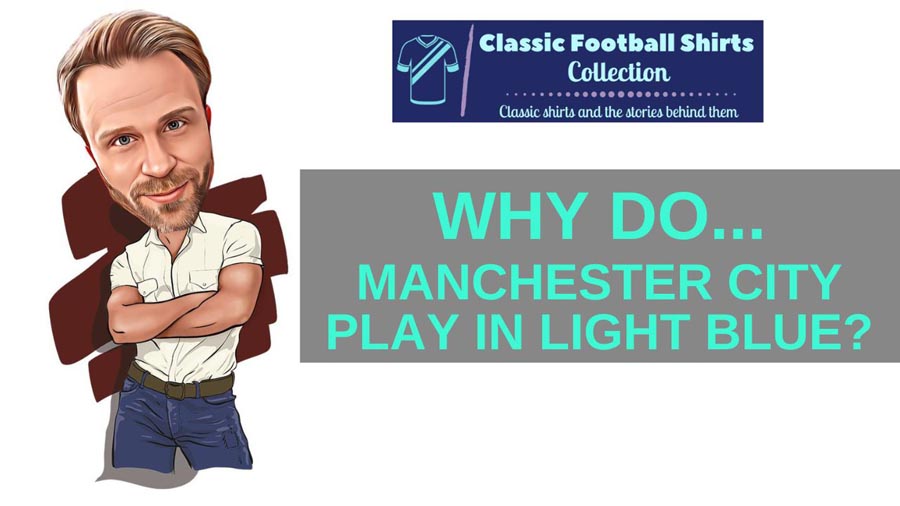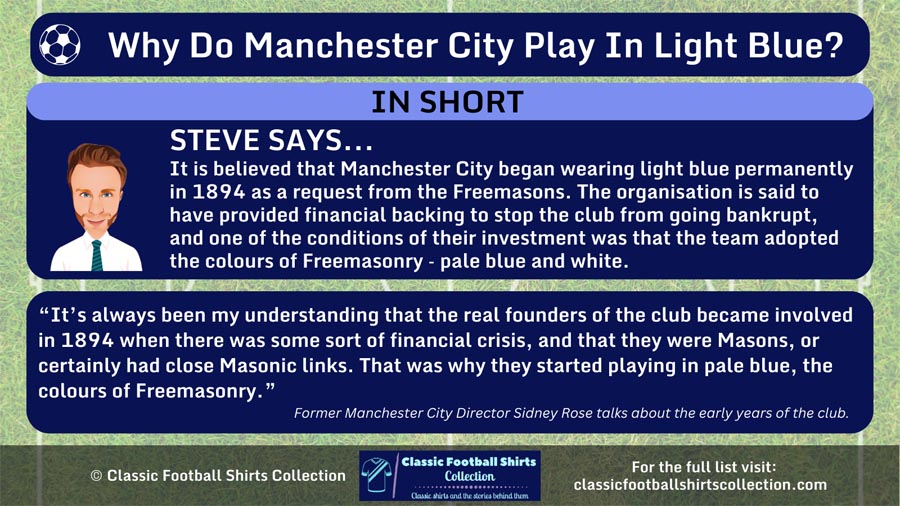
Some colours are so synonymous with clubs that we often don’t question what made them choose that colour in the first place.
Whether that be the red of Liverpool or Manchester United, the blue of Everton or the white of Tottenham, we just associated them with the respective clubs.
But in most cases there is usually a story behind the colour.
So why do Manchester City play in light blue?
Let’s take a look at that story…
Why Do Manchester City Play In Light Blue?
It is believed that Manchester City began wearing light blue permanently in 1894 as a request from the Freemasons. The organisation is said to have provided financial backing to stop the club from going bankrupt, and one of the conditions of their investment was that the team adopted the colours of Freemasonry – pale blue and white.
The Early Days
Manchester City was founded in 1880 as St Mark’s (West Gorton), before changing its name to Ardwick FC in 1887 and then to Manchester City in 1894.
As with many teams, details around the colours the club wore in its early days are a bit sketchy.
There is evidence to suggest City (or Ardwick FC as they were known then) first wore blue in 1887 when they donned royal blue and white stripes.
There is also photographic evidence that shows the team wearing what looks like white and sky blue halves in 1890.
Prior to that, in 1884, a booklet entitled Famous Football Clubs – Manchester City, published in the 1940s indicates St Mark’s (West Gorton) played in scarlet and black initially, before sporting black jerseys with a white cross from 1884.
It does seem fairly certain that from 1894, as well as the club changing its name to Manchester City, it also permanently adopted its now famous colours of pale/sky blue shirts and white shorts.
And it was only relatively recently that the apparent reason for this came to light…
RELATED ===> Revealed: The Best Retro Manchester City Shirts
Saved From Bankruptcy
In 2002 85-year-old City’s life president and former director, Sidney Rose, claimed that in 1894, with Ardwick FC in financial trouble, the Freemasons stepped in to save the club from going bankrupt.
He said that as a condition of their financial backing, the team was requested to change its name and colours.
Thus Ardwick FC became Manchester City FC and adopted the main colours of freemasonry at that time, pale blue shirts and white shorts.
Rose, who died in 2014 at the age of 96, was a surgeon and a Freemason, and in 2002 he gave an interview to Masonic Quarterly magazine talking about the role the Masons played in City’s early history:
“It’s always been my understanding that the real founders of the club became involved in 1894 when there was some sort of financial crisis, and that they were Masons, or certainly had close Masonic links.
“That was why they started playing in pale blue, the colours of Freemasonry.”
Former Manchester City Director Sidney Rose.
However this story has been disputed in some quarters, and an alternative theory has been put forward.
It is said that the eye-catching black kit with a white Maltese cross on it that St Mark’s (West Gorton) wore in 1884 also had masonic influences.
William Beastow, who played for the club, was a Mason and was said to have been responsible for obtaining the shirts for the club.
The white Maltese cross was said to have had a link with the branch of the Masons that Beastow was active in.
So it is possible Manchester City’s links with the Freemasons began at an even earlier point in its history.
A Strong Masonic Influence
The link with the Masons is corroborated by the fact that many of City’s most famous players were said to belong to various Freemason lodges.
Bert Trautmann, the German goalkeeper famous for playing in the 1956 Cup Final with a neck injury (which Sidney Rose treated), joined a Stockport Lodge in 1964 after he retired from the game.
Fellow City goalkeeper Frank Swift was also a Mason, and it was said many of Manchester City’s 1968 title-winning team were Masons, including captain Tony Book.
Hugh Murray who joined Manchester City as an apprentice in 1953 and made one appearance for the club in 1956, was also quoted in the article in Masonic Quarterly recounting the links between City and the Masons:
“The scout came to sign me and I just remember him being made up that my father, like him, was a Mason. Obviously I was too young to be involved, but I think he was quite happy, as Les McDowall, the manager at the time, was also a Mason.”
“When I was at the club there were people with Masonic connections, but we never talked about it because it was nothing to do with football. Personally, I didn’t join [the Craft] until well after I stopped playing, and if a player was a Mason then that was his business.”
Former Manchester City player and future Freemason, Hugh Murray.
The aforementioned Sidney Rose was director of Manchester City from 1966 to 1986, and at the start of his tenure there was a strong Masonic influence in the boardroom with five out of six directors belonging to the organisation.
Mark Hodkinson’s book Blue Moon substantiates this, describing the then-board prior to a takeover in 1972 as “a very old-fashioned, group of freemasons who have fallen behind the times”.
Even at the time of the article in Masonic Quarterly in 2002 it was known that three of Manchester City’s eight honorary presidents were Masons.
Final Thoughts

It seems that whichever way we look at it, the Freemasons had a big influence in the early part of Manchester City’s history.
Former director Sidney Rose says that the reason the club wears light blue dates back to the Freemasons saving the club from bankruptcy in 1894.
As part of the deal for giving them some financial backing it is said the Masons requested that City adopt the Freemasonry colours of pale blue and white as its kit.
But there have also been claims that the kit the club wore in 1884 was influenced by the Freemasons with the prominent white Maltese cross on the shirt being the symbol of a Freemason lodge that one of the players was a member of.
It seems that one way or another, the reason Manchester City play in light blue is down to the Freemasons!
